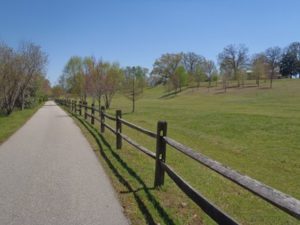
Raleigh has again been deemed the best place in America to live, this time by BusinessWeek.com. The reasons are several — good public schools, the universities, diverse cultural institutions, lots of bars and restaurants, low crime, strong (relatively) economy. Near the top of the list, great parks.
Much of what makes the area great are the key services you expect from government: good schools, economic policies that promote culture and low crime. Some, though, reflect an area willing to go that extra mile to make a top 50 city rise to the top. Great parks fall into that category.
Last night, about 250 Triangle civic leaders, government officials and activist residents gathered at the N.C. Museum of Art to push the effort to create another great park in Raleigh. Their goal:turn the 306-acre Dorthea Dix campus into a centerpiece park.
(Background: In 2006, the state announced it would close the 150-year-old mental health facility and relocate services to other facilities in the state. Debate ensued over what to do with the prime piece of real estate, which sits just off downtown Raleigh. Some saw the development potential of the land; others recognized the potential of the property as a park, a la New York’s Central Park. The later formed DIX306, a nonprofit dedicated to preserving the property. Later, a group of civic and business leaders with similar vision formed the Dix Visionaries.)
Last night’s event was led by some of the heaviest of the Triangle’s heavy hitters: Capital Broadcasting’s Jim Goodmon MC’d, Raleigh businessman Greg Poole Jr., head of the Dix Visionaries, outlined the mission, outgoing Raleigh Mayor Charles Meeker, Wake County Commissioner Erv Portman and state senator Neal Hunt all underscored the importance of preserving Dix. Their goal was to rally the choir, to get them to push Gov. Beverly Purdue to declare the Dix property a park district and to let the city purchase the land at a yet-to-be-determined fair market value. Even though it could take the state another seven years to fully abandon the property, it’s essential to get the process underway now, the gathering was told.
The crux of their message: It takes vision to look past the immediate gratification of cashing in on the Dix property and parceling it out for development and create a green space that will become increasingly more precious in a city whose population has grown more than 50 percent in the past decade. To underscore the value of vision, they showed a documentary on the father of urban park vision in America, Frederick Law Olmsted, who in the mid 1800s took 857 acres in the middle of an emerging metropolis and, budgets be damned, created what was to become the gold standard for parks in America: New York’s Central Park. Olmsted would go on to design another 500 parks, many of which, like Central Park, serve as what Olmsted described as “a ground to which people may easily go after their day’s work is done, and where they may stroll for an hour, seeing, hearing, feeling nothing of the bustle and jar of the streets; where they shall, in effect, find the city put far away from them.”
It’s not just the Olmsteds and Dix Visionaries of the world who need this vision. On Tuesday, Raleigh’s voters will be asked to show a little of that vision as well when they vote on a $40 million transportation bond. Among other things, the bond covers street resurfacing programs, some of which will add bike lanes; $4 million for sidewalk repair and $7.75 million for new sidewalk construction (vital in a city that for two decades ignored pedestrians in its transportation planning); and nearly $6 million for greenway projects, including $3.2 million for a two-mile stretch of the Walnut Creek Greenway that’s the missing link in Raleigh’s plan to link much of the city with greenway corridors. It’s vision with a cost, but it’s a pretty good deal: The transportation bond and a $16 million housing bond would cost the typical Raleigh homeowner about $17 a year in property taxes.
Those who talked about vision Thursday night didn’t talk about it in superhuman terms, like Superman being able to see through lead. To them, clear vision is something that shouldn’t require more than a $20 pair of drug store reading glasses. Addressing the Dix property, State Sen. Neal Hunt called it simply “a no-brainer.” Likewise Jim Goodmon.
“When you are working something this hard, you are often offered compromises,” Goodmon said, referring to efforts to finagle some commercial development into the property. “In this case, the answer is no.”

At a reception afterward I spotted Bill Flournoy, Raleigh’s version of Frederick Law Olmsted. In the early 1970s, as a graduate student at N.C. State, Flournoy came up with a plan to create linear parks along Raleigh’s floodplains. His linear parks concept quickly gave rise to the Capital Area Greenway System, a network of more than 200 miles of paved paths lined with green snaking through Raleigh. At the core of the plan were four main greenways — east/west along Walnut Creek and Crabtree Creek, north/south along the Neuse River and Rocky Branch— that would serve as super corridors linking much of the city. By early 2013, that core network will be two miles shy of done; if voters approve Tuesday’s transportation bond, that last two miles could be in place by 2015.
I expected Flournoy to be, if not overwhelmed by what has become of his vision, then at least pleasantly surprised. His response was that of someone confident of reading an eye chart from two blocks away.
“It was inevitable,” the reserved Flournoy said, “at least to me.” Then, referring to the near-sighted bureaucrats who often find themselves squinting to see down the road, he added, “To me, it was just a matter of convincing them.”